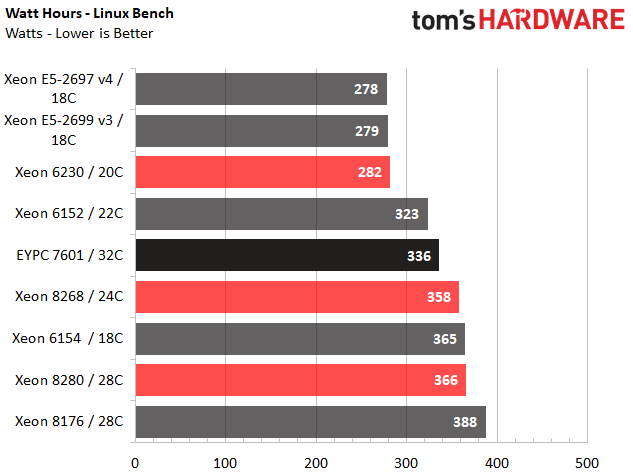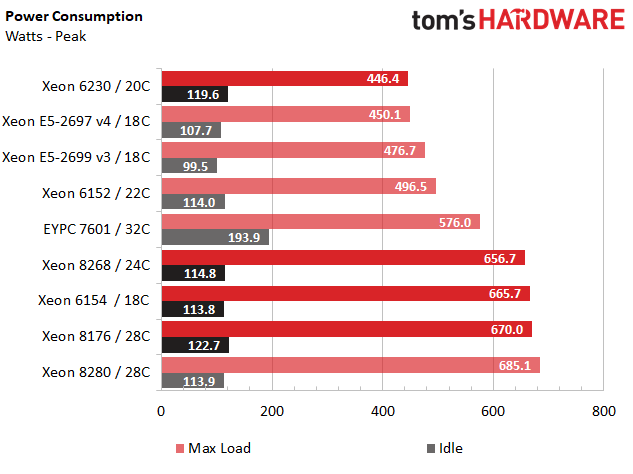Intel Cascade Lake Xeon Platinum 8280, 8268, and Gold 6230 Review: Taking The Fight to EPYC
Why you can trust Tom's Hardware
Power Consumption
Linux-Bench Power Consumption
Power consumption is of critical importance in the data center. It's an ongoing expense that must be factored into total cost of ownership and managed accordingly. It also correlates with waste heat, necessitating cooling that eats up even more power.
We logged platform power consumption during our Linux-Bench run, so these measurements also include the effects of DRAM and power supply efficiency.
Factoring in the amount of work performed per watt provides the best view of overall power efficiency. Generalizing remains a challenging endeavor, though. Because these processors cover such a wide range of target markets and relevant workloads, it's hard to identify a handful of tests applicable to everyone. As such, consider these results a basic indicator of overall power consumption.
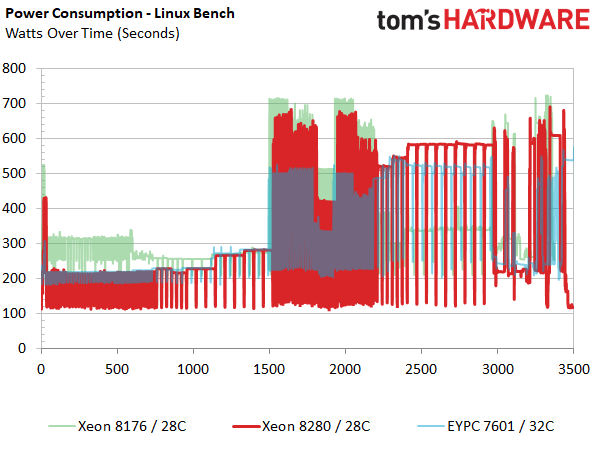
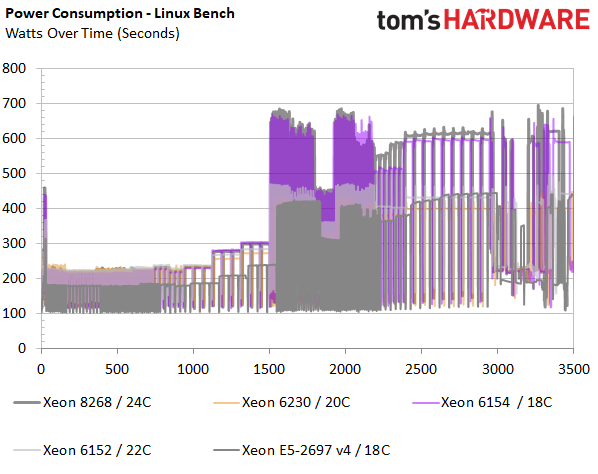
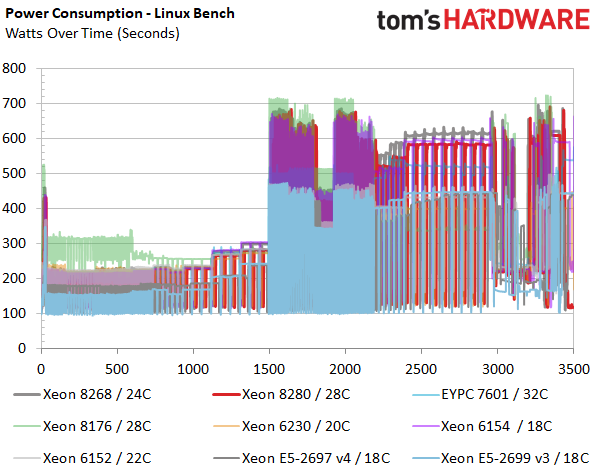
It isn't surprising to see the 28-core Xeon 8280 consuming more power than the other modern chips (though less than the previous-gen 8176) as we work through demanding portions of the tests. But it is interesting to see generally lower power consumption from the EPYC 7601, especially during the heavily threaded tests (peaks in the middle of the chart) where its performance is the most competitive.
Further down the hierarchy, Intel's Xeon 6230 sips power in accordance with its 125W TDP rating, which is the lowest of the test pool. However, as with all Intel chips, this specification only applies to normal operation at base frequencies, so we do see peaks in excess of 400W as the chip opportunistically cranks up the clock rate.
Watt Hours
We also measured the watt-hours consumed during the Linux-Bench test suite. Intel's Xeon 8280 consumes less power than the previous-gen 8176, though we have to remember that the processors are rated at 205W and 165W, respectively. Again, the EPYC 7601 consumes roughly 8% less power than the 8280.
Power Maximum Load And Idle
Power draw is recorded every second in our enterprise lab to quantify peak power consumption.
Get Tom's Hardware's best news and in-depth reviews, straight to your inbox.
Although the Xeon 8280 draws less power overall than the 8176, we did record a higher 685W peak during testing. This was caused by the more aggressive clock rates that go along with a higher TDP.
The EPYC 7601 peaks far lower, but also uses a lot more power at idle. We do caution that idle power consumption measurements are somewhat apples-to-oranges between the Intel and AMD chips due to platform, DRAM, and power supply variations.
MORE: Best CPUs
MORE: Intel & AMD Processor Hierarchy
MORE: All CPU Content

Paul Alcorn is the Editor-in-Chief for Tom's Hardware US. He also writes news and reviews on CPUs, storage, and enterprise hardware.
-
Murissokah In the first page there's a paragraph stating "Like the previous-gen Xeon Scalable processors, Intel's Cascade Lake models drop into an LGA 4637 interface (Socket P) on platforms with C610 (Lewisburg) platform controller hubs, and the processors are compatible with existing server boards."Reply
Wouldn't that be LGA 3647? And shouldn't it read C620-famliy chipset for Lewisburg? -
JamesSneed It just hit me how big of a deal EPYC will be. AMD is already pulling lower power numbers with the 32 core 7601 however AMD will have a 64 core version with Zen2 and has stated the power draw will be about the same. If the power draw is truly is the same, AMD's 64 core Zen2 parts will be pulling less power than Intel's 28 core 8280. That is rather insane.Reply -
Amdlova lol 16x16gb 2666 for amdReply
8x32gb intel 2400
12x32gb intel 2933
How To incrase power compsumation to another level. add another 30w in memory for the amd server and its done. -
Mpablo87 The promise or realityReply
Cascade Lake Xeons employ the same microarchitectur as their predecessors, but, we can hope, it is promising!) -
The Doodle Slight problem this author fails to tell you in this article and that's OEM's can only buy the Platinum 9000 processor pre-mounted on Intel's motherboards. That's correct. None of the OEM's are likely to ship a solution based on this beast because of this fact. So at best you will be able to buy it from an Intel reseller. So forget seeing it from Dell, HPE, Lenovo, Supermico and others. your in white box territory.Reply
Besides, why would they? A 64C 225W AMD Rome will run rings around this space heater and cost a whole lot less.
